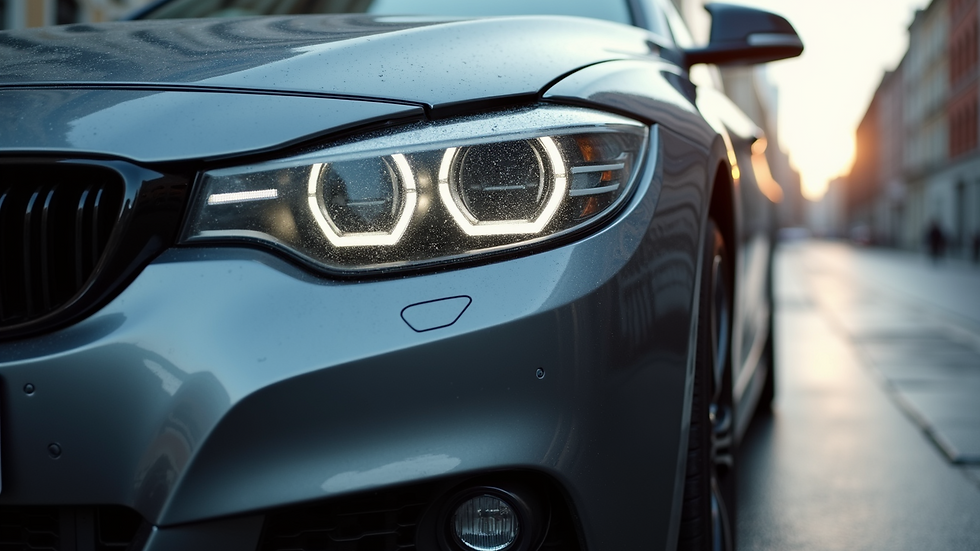Best Methods for Vehicle Paint Protection
- Kelton Anderson
- Jul 29
- 4 min read
Protecting your car's paint is essential to maintain its appearance and value over time. Exposure to sunlight, dirt, road debris, and weather conditions can cause fading, scratches, and other damage. Fortunately, there are several effective car paint protection methods available that can help keep your vehicle looking new for years. This article explores the best options, their benefits, and what to consider when choosing the right protection for your car.
Top Car Paint Protection Methods to Consider
When it comes to preserving your car’s finish, several popular methods stand out. Each offers unique advantages depending on your budget, lifestyle, and how much protection you want.
1. Waxing
Waxing is one of the oldest and most traditional ways to protect car paint. It involves applying a thin layer of natural or synthetic wax to the surface, which creates a protective barrier against dirt and UV rays.
Pros: Affordable, easy to apply, enhances shine.
Cons: Lasts only a few weeks to months, requires frequent reapplication.
Waxing is ideal for car owners who want a quick and inexpensive way to boost their car’s appearance but don’t mind regular upkeep.
2. Sealants
Sealants are synthetic products designed to bond with the paint surface, offering longer-lasting protection than wax. They provide a glossy finish and repel water and contaminants.
Pros: Durable for 4-6 months, easy to apply, enhances gloss.
Cons: Can be more expensive than wax, may require some prep work.
Sealants are a great middle ground for those seeking better durability without the high cost of professional coatings.
3. Ceramic Coatings
Ceramic coatings are advanced liquid polymers that chemically bond to the paint, creating a hard, protective layer. They offer superior resistance to scratches, chemicals, and UV damage.
Pros: Long-lasting (1-3 years), high gloss, easy cleaning.
Cons: Higher upfront cost, professional application recommended.
Ceramic coatings are perfect for car enthusiasts who want premium protection and a showroom shine with minimal maintenance.

4. Paint Protection Film (PPF)
PPF is a clear, thick polyurethane film applied to the car’s surface. It acts as a physical shield against rock chips, scratches, and stains.
Pros: Excellent impact protection, self-healing properties, invisible.
Cons: Expensive, professional installation required, can yellow over time.
PPF is ideal for drivers who frequently travel on highways or rough roads and want maximum protection against physical damage.
What is the downside of PPF?
While Paint Protection Film offers outstanding defense against physical damage, it does have some drawbacks to consider:
Cost: PPF is one of the most expensive protection methods due to material and installation costs.
Installation: Requires professional application to avoid bubbles, wrinkles, or peeling.
Maintenance: Needs special cleaning products to avoid damaging the film.
Yellowing: Over time, cheaper films may yellow or discolor, affecting appearance.
Limited lifespan: Typically lasts 5-7 years before needing replacement.
Despite these downsides, many car owners find the benefits of PPF outweigh the negatives, especially for high-value or frequently driven vehicles.

How to Choose the Right Car Paint Protection Method
Selecting the best protection depends on several factors:
Budget: Wax and sealants are budget-friendly, while ceramic coatings and PPF require more investment.
Usage: Frequent highway drivers benefit from PPF, while city drivers may prefer ceramic coatings or sealants.
Maintenance: Consider how much time you want to spend on upkeep. Ceramic coatings reduce washing frequency.
Appearance: If you want a high-gloss finish, ceramic coatings and sealants excel.
Longevity: For long-term protection, ceramic coatings and PPF are superior.
It’s also important to prepare your car properly before applying any protection. This includes washing, claying, and sometimes polishing to remove contaminants and imperfections.
Professional vs. DIY Application
Many car paint protection methods can be applied at home, but some require professional expertise:
DIY-friendly: Wax, sealants, and some ceramic coatings.
Professional only: High-quality ceramic coatings and PPF.
Professional application ensures even coverage, proper curing, and maximizes the lifespan of the protection. It also reduces the risk of mistakes that could damage your paint.
Enhancing Protection with Graphene Ceramic Coatings
A newer innovation in the market is graphene ceramic coatings. These coatings incorporate graphene, a material known for its strength and heat resistance, to improve durability and hydrophobic properties.
Benefits: Better scratch resistance, enhanced heat dissipation, longer-lasting shine.
Application: Usually requires professional installation.
For those seeking cutting-edge technology in vehicle paint protection, graphene ceramic coatings are an excellent choice. You can learn more about this advanced option at vehicle paint protection.

Maintaining Your Car’s Paint Protection
No matter which method you choose, proper maintenance is key to extending its life:
Regular washing: Use pH-neutral car shampoo to avoid stripping protection.
Avoid harsh chemicals: Stay away from abrasive cleaners or solvents.
Quickly remove contaminants: Bird droppings, tree sap, and bug splatter can damage paint if left too long.
Use microfiber towels: Prevent scratches during drying and cleaning.
Schedule reapplications: Follow product guidelines for reapplying wax, sealants, or coatings.
By following these simple steps, you can keep your car’s finish looking fresh and protected for years.
Final Thoughts on Protecting Your Car’s Paint
Choosing the right car paint protection method depends on your needs, budget, and how much effort you want to invest. From traditional waxing to advanced graphene ceramic coatings and PPF, there are options for every driver. Investing in quality protection not only preserves your car’s beauty but also helps maintain its resale value.
Explore the latest in vehicle paint protection to find the best solution that fits your lifestyle and keeps your car looking its best on the road.




